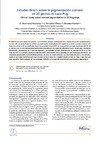Please use this identifier to cite or link to this item:
https://accedacris.ulpgc.es/jspui/handle/10553/57507
| Title: | Estudio clínico sobre la pigmentación corneal en 20 perros de raza Pug | Authors: | Sarmiento Quintana, D. González-Pérez, J. Morales Fariña, Inmaculada |
UNESCO Clasification: | 310907 Patología 320109 Oftalmología |
Keywords: | Córnea Pigmentación Pug Perros Queratitis |
Issue Date: | 2016 | Journal: | Clínica veterinaria de pequeños animales | Abstract: | El objetivo de este trabajo fue estudiar la prevalencia, factores predisponentes y signos clínicos de la pigmentación corneal (CP) en perros Pugs. Se realizó una exploración oftalmológica del segmento anterior y anejos oculares a 20 Pugs. De existir la CP se clasificaba según la gravedad: leve (<20% de la superficie corneal), moderada (20-50%) o severa (>50%). Los factores predisponentes evaluados en los pacientes afectados fueron edad, sexo, anomalías palpebrales, alteraciones de la película lagrimal y sensibilidad corneal. Conclusiones: la prevalencia de la CP, fue muy alta (95%). La edad y la película lagrimal están relacionadas con la gravedad de esta patología; en cambio, las anomalías palpebrales, la sensibilidad corneal y el sexo no tienen relación. Los resultados de este y otro estudio, sugieren que estos factores puede que no sean la única causa de la pigmentación corneal en Pugs, y que hay una base genética. Podría tratarse de una patología distinta; se ha sugerido denominarla queratopatía pigmentaria. The aim of this sud was to evaluate the prevalence, predisposing factors and clinical signs of corneal pigmentation (CP) in Pug dogs. An eye examination of the anterior segment and ocular adnexa was performed in 20 Pugs. In case of confirmed CP, it was classified according to severity as mild (<20% of the corneal surface), moderate (20-50%) or severe (>50%). The predisposing factors evaluated in affected patients were the age, the sex, the eyelid abnormalities, the alterations of the tear film and the corneal sensitivity. Conclusions: The prevalence of CP was very high (95%). Age and tear film are related to the severity of this disease. However, eyelid abnormalities, corneal sensitivity and sex are not related. The results of this and other studies suggest that these factors may not be the only cause of corneal pigmentation in Pugs and there is a genetic basis. It could be a different pathology which has been suggested to be denominated as pigmentary keratopathy. |
URI: | https://accedacris.ulpgc.es/handle/10553/57507 | ISSN: | 1130-7064 | Source: | Clínica veterinaria de pequeños animales: revista oficial de AVEPA, Asociación Veterinaria Española de Especialistas en Pequeños Animales [ISSN 1130-7064], v. 36 (2), p. 117-121 | URL: | http://dialnet.unirioja.es/servlet/articulo?codigo=5838228 |
| Appears in Collections: | Artículos |
Page view(s)
504
checked on Aug 17, 2024
Download(s)
487
checked on Aug 17, 2024
Google ScholarTM
Check
Share
Export metadata
Items in accedaCRIS are protected by copyright, with all rights reserved, unless otherwise indicated.
